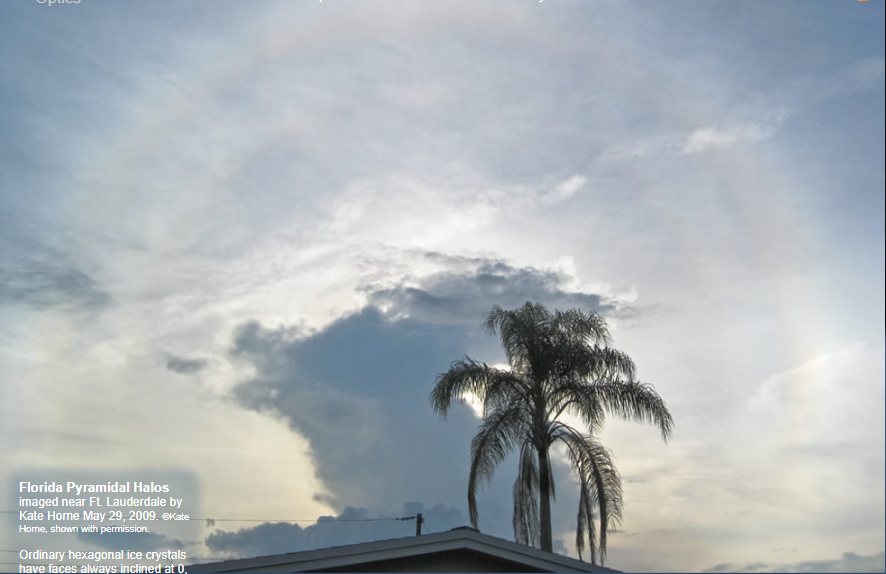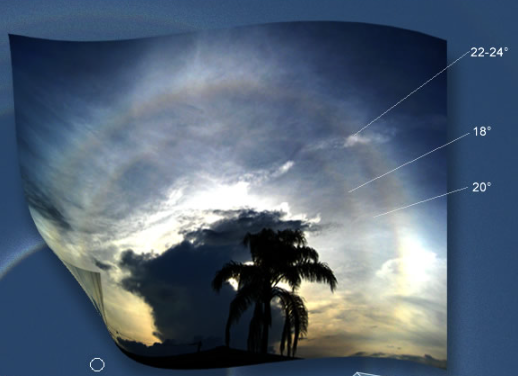Florida Pyramidal halos
Florida Pyramidal Halos: A Rare Atmospheric Phenomenon
Florida is known for its beautiful beaches, sunny weather, and diverse wildlife. But did you know that it is also a place where rare atmospheric optics phenomena can occur? One such phenomenon is the Florida Pyramidal Halos, which have fascinated sky watchers and scientists alike.
Understanding Hexagonal Ice Crystals and Halo Formation
Ordinary hexagonal ice crystals have faces that are inclined at specific angles to each other - 0, 60, 90, and 120 degrees. When light passes through the space between the 60 and 90 degree inclined faces of these crystals, it produces the familiar 22° circular halo that we often see around the Sun or Moon. In rare cases, a 46° halo may also be observed.
Pyramidal Ice Crystals: A World of Possibilities
When hexagonal ice crystals have pyramidal ends, the possibilities for halo formation increase significantly. These crystals can have up to 20 faces inclined at various "wedge angles" such as 28, 52, 56, 60, 62, 64, 80, and 90 degrees. This abundance of faces leads to the formation of several "odd-radius" halos, which are not commonly seen.
The Intricate Patterns of Florida Pyramidal Halos
In the case of Florida Pyramidal Halos, the inner halo has a radius of 18°. This halo is formed by rays passing between faces inclined at 52°. As we move further out, traces of a 20° halo become visible. Beyond that, a jumble of halos with radii of 22°, 23°, and 24° can be observed. Unfortunately, due to lower clouds and trees obscuring the view, a potential 9° halo could not be confirmed.
Partial Orientation: The Key to More Halos
Pyramidal ice crystals have a higher likelihood of forming halos when they are partially oriented. This means that they are not perfectly aligned, allowing for a greater variety of light paths and halo formations. The unique structure of pyramidal crystals, with their multiple inclined faces, provides the conditions for these mesmerizing atmospheric displays.
Crystal Face Angles: Nature's Precision
The angles of crystal faces in pyramidal ice crystals are not arbitrary. They form in directions that correspond to well-populated planes of atoms in the crystal lattice, and they always make the same angles to each other. This precise arrangement of crystal faces is what gives rise to the specific wedge angles and the resulting halo formations.
Exploring the Unusual: Potential for Elliptical Halos
While everyday ice with its hexagonal structure could theoretically form crystals with different sets of angles, they would be quite rare. Although halos from such crystals have not been observed, there is an exception - the enigmatic elliptical halos. These elliptical halos have been documented and are believed to be a result of unique crystal orientations or atmospheric conditions.
Captivating Images of Florida Pyramidal Halos
The images captured by Kate Horne near Ft. Lauderdale on May 29, 2009, beautifully showcase the Florida Pyramidal Halos. These photographs offer a glimpse into the intricate patterns and mesmerizing colors created by the interaction of light with pyramidal ice crystals. Such images serve as a reminder of the stunning natural phenomena that can occur right above our heads.
In conclusion, the Florida Pyramidal Halos are a rare and captivating atmospheric optics phenomenon. The unique structure of pyramidal ice crystals allows for the formation of numerous halos with varying radii. Partial orientation of these crystals further enhances the chances of witnessing these mesmerizing displays. While these halos may be relatively uncommon, they serve as a reminder of the hidden wonders that can be found in the skies above us. So, the next time you find yourself in Florida, don't forget to look up and marvel at the beauty of the pyramidal halos that may grace the horizon.

Florida Pyramidal Halos imaged near Ft. Lauderdale by Kate Horne May 29, 2009. ©Kate Horne, shown with permission.
Ordinary hexagonal ice crystals have faces always inclined at 0, 60, 90 and 120 degrees to each other. Rays passing between the 60 and 90 degree inclined faces of poorly oriented crystals produce the familiar 22� circular halo and the rare 46�.
When hexagonal ice crystals have pyramidal ends there are many more opportunities for halo formation. They can have up to 20 faces inclined at 'wedge angles' of 28, 52, 56, 60, 62, 64, 80 and 90 degrees. The result - a number of so called "odd-radius" halos.
Here the inner halo is 18� in radius from rays passing between faces inclined at 52� (ray paths like 13-25, see here for face numbers).
Further out there are traces of a 20� halo.
Beyond that is a characteristic jumble of halos of radius 22,23 and 24�.
There was probably a 9� halo too but the lower cloud and tree obscured that.
Pyramidal crystals form more halos when they are partially oriented.
Crystal face angles are not arbitrary. They form in directions corresponding to well populated planes of atoms in the crystal lattice and always make the same angles to each other.
Everyday ice with its hexagonal structure could theoretically form crystals with other sets of angles. They can easily be calculated but would be unusual. Halos from them have not been observed with the possible exception of the enigmatic elliptical halos.


Note: this article has been automatically converted from the old site and may not appear as intended. You can find the original article here.
Reference Atmospheric Optics
If you use any of the definitions, information, or data presented on Atmospheric Optics, please copy the link or reference below to properly credit us as the reference source. Thank you!
-
<a href="https://atoptics.co.uk/blog/florida-pyramidal-halos/">Florida Pyramidal halos</a>
-
"Florida Pyramidal halos". Atmospheric Optics. Accessed on November 21, 2024. https://atoptics.co.uk/blog/florida-pyramidal-halos/.
-
"Florida Pyramidal halos". Atmospheric Optics, https://atoptics.co.uk/blog/florida-pyramidal-halos/. Accessed 21 November, 2024
-
Florida Pyramidal halos. Atmospheric Optics. Retrieved from https://atoptics.co.uk/blog/florida-pyramidal-halos/.